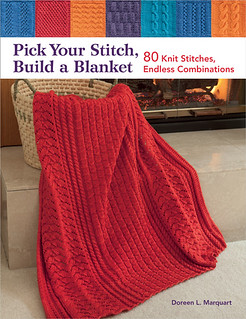First, the facts:
Title: Pick Your Stitch, Build Your Blanket: 80 Knit Stitches, Endless Combinations
Author: Doreen L. Marquart
Published by: Martingale Press, 2015
Pages: 98
Type:
Chapters:
Introduction
Getting Started
The Blocks–80 Stitch Patterns
Sampler-type Afghans
Single-Pattern Afghans
Vertically Patterned Afghans
Horizontally Patterned Afghans
Knitting Basics
Assembly Basics
Useful Information
Stitch Index
The In-Depth Look:
Tell me, how do you feel about stitch dictionaries?
Personally, I love them, because I not only enjoy browsing the variety of patterns and textures that knitters have created out of knits and purls, but I love finding just the right one to knit into a sweater or a blanket.
Except, not everyone knows how to do that—which is what inspired Doreen L. Marquart to write this book.
She says in her introduction that she often recommends the 365 Knitting Stitches a Year Perpetual Calendar to the customers of her yarn shop, but that, “a vast number of knitters don’t know how to adapt and use these stitch patterns to actually knit an afghan. … I’ve completed the necessary calculations for 80 of the stitch patterns from the calendar so that no matter what yarn or needle size you use, as long as you use the same yarn weight and needle size for each block, your finished blocks will be identical in size after blocking. … Once you discover how easy the entire process is, a whole new world of possible uses for the calendar will be at your fingertips. Let the fun begin!”
She starts by explaining how to figure out how many blocks you’ll need for your afghan, depending on the block size and how big you want the finished project to be. Then she immediately dives into the blocks—80 different stitch patterns adapted into small blocks (30 stitches for 48 rows) or large blocks (46 stitches over 80 rows). Right away, you’ve got full-color visuals of exactly what your own blocks would look like, complete with garter stitch borders all around. The patterns run the gamut from basic texture (like seed stitch) to lace to cables.
The rest of the book is broken down into types of afghans, starting with the sampler type—the kind of afghan made up of different blocks assembled into one blanket. The three afghans that follow vary by color palate, but are leave plenty of choices to the knitter—you don’t have to use the same stitches she used, after all!
The next section is for single-color afghans—afghans made entirely in one color, one stitch pattern, then come the vertically or horizontally-patterned afghans. These are more specific patterns—giving you precise instructions on how to make the afghan you’re looking at. There is some basic explanation on how to combine the different stitches, but it mostly comes down to a paragraph or two at the head of each section. I’m not sure I would find this enough explanation if I were uncertain about how to do this, but the idea is to be creative, right? To guide without too much hand-holding?
The afghans given are lovely, and they come along with notes and hints about construction.
All in all, a good book to help knitters figure out what to do with those stitch dictionaries … and to keep warm at the same time! You can get your copy here at Amazon.com or at your local bookstore.
Want to see bigger pictures? Click here.

This review copy was kindly donated by Martingale Press. Thank you!


